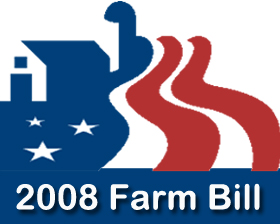
In the United States, the farm bill is comprehensive omnibus bill that is the primary agricultural and food policy instrument of the federal government.[1] Congress typically passes a new farm bill every five to six years.[2][3]
Congress makes amendments to provisions of permanent law, reauthorizes, amends, or repeals provisions of preceding temporary agricultural acts, and puts forth new policy provisions for a limited time into the future. Beginning in 1933, farm bills have included sections ("titles") on commodity programs, trade, rural development, farm credit, conservation, agricultural research, food and nutrition programs, marketing, etc.[4]
Some provisions are highly controversial. Provisions can impact international trade, the environment, the food supply, food safety, and the economies of rural America. Powerful interest groups are poised to intervene, including organizations claiming to represent farmers (such as the American Farm Bureau Federation), as well as big agribusiness corporations (such as John Deere, Cargill, Pioneer Hi Bred International (owned by Corteva since 2019), and Monsanto (owned by Bayer since 2018). Congress is polarized along lines of ideology and interest groups. Republicans are more conservative, represent rural areas,[5] and are tied to agricultural[6] and businesses groups, while Democrats are more liberal and tied to environmentalists, cities, and labor unions. Critics sometimes warn against putting together the agricultural and nutrition parts. However, doing so helps to bridge some of the politically relevant cultural differences that exist between legislators of urban and rural, coastal and heartland areas of the country.[7] Traditionally, the agriculture programs have been more important for rural areas of the heartland, while urban and coastal regions have been more concerned with the nutrition assistance programs. There are stakeholders outside of the government that are also interested in food and agriculture issues. These include national farm groups, commodity associations, state organizations, nutrition and public health officials, advocacy groups representing conservation, recreation, rural development, faith-based interests, local food systems, and organic production.[3] Putting nutrition and agriculture topics together allows for stakeholders and advocacy coalitions with different interests to find common ground on topics that are potentially contentious between them.[3][7]
Some of the programs that are authorized in a farm bill fall into the spending category of mandatory, while others are discretionary.[3] Programs with mandatory funding have their funds authorized directly within the farm bill. On the other hand, programs with discretionary funding require for congressional appropriators to designate funding to them because they are not funded directly in the farm bill. Cost projections for funding estimates are calculated by the Congressional Budget Office using a baseline, which is an estimate of future costs over ten years if the existing costs were to continue unchanged. Adjustments to funding levels between programs generally occurs from one year to the next, incrementally.[7]
In November 2023, President Joe Biden signed into law H.R. 6363 that extended the Agriculture Improvement Act of 2018, also known as the 2018 United States farm bill, until September 20, 2024.[8]
- ^ Johnson, Renée; Monke, Jim (October 5, 2017). What is the Farm Bill? (PDF). Washington, DC: Congressional Research Service. Retrieved 12 October 2017.
- ^ Monke, Jim (May 31, 2018). Farm Bills: Major Legislative Actions, 1965-2018 (PDF). Washington, DC: Congressional Research Service. Retrieved 14 June 2018.
- ^ a b c d Johnson, R. and Monke, J. (8 March 2019). 2018 Farm Bill Primer: What is the Farm Bill?. Congressional Research Service Report. Retrieved from https://crsreports.congress.gov/product/pdf/IF/IF11126
- ^ CRS Report for Congress: Agriculture: A Glossary of Terms Programs and Laws, 2005 Edition – Order Code 97-905 Archived August 10, 2011, at the Wayback Machine,
- ^ Explaining the Urban-Rural Political Divide https://www.niskanencenter.org/explaining-the-urban-rural-political-divide/
- ^ "American Farm Bureau Political Donations". opensecrets.org.
- ^ a b c Wilde, Parke (2018-04-09). Food policy in the United States : an introduction (Second ed.). New York, NY. ISBN 978-1-315-47031-3. OCLC 1028731689.
{{cite book}}: CS1 maint: location missing publisher (link) - ^ "Farm Bill Home". national-content. 2020-09-24. Retrieved 2023-12-10.
